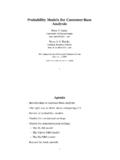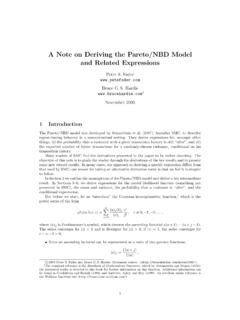Transcription of RFM summary in Excel - Bruce Hardie's Home Page
1 Creating an rfm summary Using ExcelPeter S. G. S. December 20081. IntroductionIn order to estimate the parameters of transaction-flow models such as thePareto/NBD (Schmittlein, Morrison, and Colombo 1987) and BG/NBD(Fader, hardie , and Lee 2005a), as well as those of the associated models forspend per transaction (Schmittlein and Peterson 1994; Fader, hardie , andLee 2005b), we need an RFM (recency, frequency, monetary value) summaryof each customer s purchasing behavior. In particular, The transaction-flow model requires three pieces of information abouteach customer s purchasing history: their recency (whentheir lasttransaction occurred), frequency (how many transactions they madein a specified time period), and the length of time over which we haveobserved their purchasing behavior.
2 The notation used to representthis information is (x, tx, T), wherexis the number of transactionsobserved in the time period (0, T] andtx(0 tx T) is the time ofthe last transaction. The spend model requires two pieces of information about each cus-tomer s purchasing history: the average monetary value of eachtransaction (denoted bymx) and the number of transactions overwhich this average is computed ( , frequency,x).In this note we describe how to create such a summary from raw customer-level transaction data using pre-Office 2007 versions of Excel . (The onlyissue with the Office 2007 version of Excel is that some of the menu-relatedinstructions given in this note are no longer correct.))
3 Readers familiar withExcel 2007 should be able to work out the necessary changes for themselves.) c 2008 Peter S. Fader and Bruce G. S. hardie . This document, along with a copy ofthe resulting spreadsheet, can be found at< >.12. PreliminariesWe will make use of the CDNOW dataset, as used in Fader et al. (2005a,b).The master dataset contains the entire purchase history up to the end of June1998 of the cohort of 23,570 individuals who made their first-ever purchaseat CDNOW in the first quarter of 1997. (See Fader and hardie (2001) forfurther details about this dataset.)The purchasing data for a 1/10th sys-tematic sample of the whole cohort (2357 customers).
4 Each record in thisfile, 6919 in total, comprises five fields: the customer s ID inthe masterdataset, the customer s ID in the 1/10th sample dataset (ranging from 1 to2357), the date of the transaction, the number of CDs purchased, and thedollar value of the start the process of creating our summary of each customer s pur-chasing in the following manner:2 We import the text an empty blank Excelworkbook. We note that the associated worksheet is calledCDNOW sample.(We assume that the records in the raw transaction data file aregrouped by customer, and sorted within customer by date of trans-action. If in doubt, sort the raw dataset by customer ID and date oftransaction.)
5 As they are of no interest to us in this particular case (unlike, say,in Fader and hardie (2001)), we delete the first and fourth columns(master dataset customer ID and # CDs purchased, respectively). Weinsert a row at the top of the worksheet, adding field names: ID, Date,Spend. (See Figure 1.)12345676917691869196920 ABCIDDate Spend1 1: Raw transaction data1 that the following steps are not meant to represent the most elegant approachto the task of creating the rfm summary ; Excel experts will beable to identify Scrolling down the dataset, we note that some customers had morethan one transaction on a given day. For example, customer 26hadtwo separate transactions on 13 January 1997, while customer 46 hadtwo separate transactions on 28 August 1997.
6 Typing=IF(AND(A2=A1,B2=B1),1,0)into cellD2and copying it down to cellD6920, we note that cellsD2:D6920sum to 223, indicating that there are a total of 223 such additional transactions. The transaction-flow models are developed by telling a storyaboutinterpurchase times. As we only know the date (and not the time)of each transaction, we need to aggregate the records associated withsame-day transactions we can t have an interpurchase timeof 0. Wedo so in the following manner: Deleting the current contents of columnD, we type=IF(AND(A2=A1,B2=B1),C2+D1,C2)into cellD2and copy it down to cellD6920. This creates a runningwithin-transaction-day total spend for each customer.
7 For those situations where a customer has more than one trans-action in a day, we wish to identify the all-but-last transactions(and then delete them). We type=IF(AND(A2=A3,B2=B3),1,0)into cellE2and copy it down to cellE6920. We then copy and paste special / values cellsD2:E6920onto themselves. Nextwe sort the whole block of data by columnE ascending (with a header row ) and delete the rows for which columnEcontainsa 1, a total of 223 rows. Finally, resorting the block of data by ID and Date (both as-cending ), deleting columnsCandE, and labeling the new columnCSpend gives us a raw transaction dataset in which no customerhas more than one transaction on any given Frequency and Monetary Value Now that we have a clean raw transaction dataset, we can compute thefrequencyandmonetary valuesummaries for each of the previous analyses undertaken using this datasethave splitthe 78 weeks of data in half, creating a 39-week calibration period (1997-01-01 1997-09-30) and 39-week validation period (1997-10-01 1998-06-30).
8 Furthermore, these analyses have generally ignored each customer s first-everpurchase at CDNOW, which signals the start of the customer s relation-ship with the firm; this means calibration-period frequency has usually3been the number ofrepeattransactions, and monetary value has been theaverage dollar value per repeat transaction. In order to identify each transaction as being the first-everpurchase forthe customer, a calibration-period repeat transaction, orvalidation-period transaction, we enter=IF(A2<>A1,"first",IF(B2<=19970930,"calib","vali d"))into cellD2, copy it down to cellD6920, labeling the column Period(cellD1). We can now create the desired frequency summary table using the pivot tables feature in Excel .
9 We highlight the cell rangeA1:D6697and select thePivotTable and PivotChart ..option under theDatamenu. We use ID as therow field, Period as thecolumn field, and IDas thedata item. (Make sure the Pivot Table Field is Count ofID , not sum or some other summary of the ID field.) We rename theworksheet containing the resulting tablePivot Table 1; this reportsthe number of repeat transactions made by each of the 2357 customersin the calibration and validation periods. We now compute the average spend per repeat transaction for the cal-ibration and validation periods in a similar manner. Going back totheCDNOW sampleworksheet, we highlight the cell rangeA1:D6697,and select thePivotTable and PivotChart.
10 Option under theDatamenu. We use ID as therow field, Period as thecolumn field, andSpend as thedata item. (Make sure the Pivot Table Field is Av-erage of Spend , not sum or some other summary of the Spend field.)We rename the worksheet containing this reportPivot Table Recency The next step is to computerecency, as well as the length of time over whichwe have observed each customer s purchasing behavior. To identify the date on which each customer made their first-everpurchase at CDNOW, we go back to theCDNOW sampleworksheet andtype=IF(A2<>A1,B2,0)into cellE2, copy it down to cellE6920, labeling the column FirstPurchase (cellE1). Highlighting the cell rangeA1:E6697, we select thePivotTable andPivotChart.


